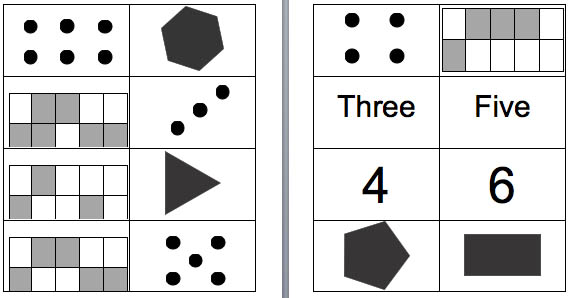Or search by topic
Number and algebra
Geometry and measure
Probability and statistics
Working mathematically
Advanced mathematics
For younger learners
Number Match



- Problem
- Student Solutions
- Teachers' Resources
Number Match
Number Match printable instruction sheet
This is one of a series of problems designed to develop learners' team working skills. Other tasks in the series can be found by going to this article.

What are you aiming to do?
For the task:
Every member of the team has to end up with a set of four cards in front of them that are related to each other in a similar way. The task is only successfully completed when everyone on the team has completed their set.As a team:
- Responding to the needs of others
- Helping others to do things for themselves.
Getting started
Tackling the problem
How to play
Players pass cards to other team members in order to help one another complete their set.
Rules
- No one can talk or give non-verbal signals to other members of the team.
- Each member of the team starts with four cards in front of them.
- The cards in front of each person should be visible to everyone.
- Team members can only give cards; they cannot take cards from someone else.
- Each team member must have at least two cards in front of them at all times.
Why do this problem?
This team-building task is designed to develop learners' team-working skills. If you wish to learn more about these skills and find other team-builder tasks look at this article.
This task depends upon members of the group noticing the needs of others and responding. It requires learners to:
- respond to the needs of others
- consider the needs of the whole group
- help others to do things for themselves.
Possible approach
Share the purposes of the activity and the rules with the group.
If you have more than four people in a group then use an observer to ensure the team obeys the rules and notes when there is evidence of members of the team responding to the needs of others.
Why not let us know how the children have got on with their group-working skills by clicking on the 'Submit a solution' link?
Key questions
- Can you give any good examples of when someone noticed what you needed and tried to help?
Possible extension
Other skill-building tasks can be found by going to this article.
Possible support
Other skill-building tasks can be found by going to this article.
You may also like
Consecutive Numbers
An investigation involving adding and subtracting sets of consecutive numbers. Lots to find out, lots to explore.
Roll These Dice
Roll two red dice and a green dice. Add the two numbers on the red dice and take away the number on the green. What are all the different possible answers?

